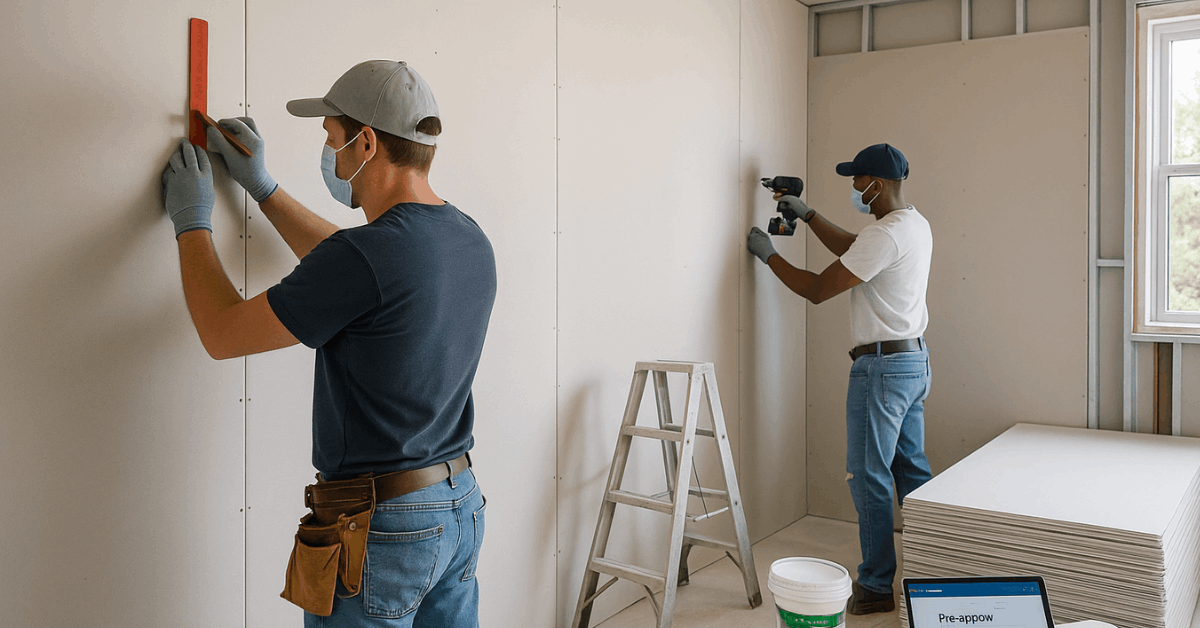Drywall work covers measuring, cutting, fastening, taping, and finishing to deliver paint-ready surfaces in homes and commercial spaces. In this field, you match skills to roles such as installer, finisher, estimator, or project lead, while learning site safety and plan reading.
Strong hiring demand across Brazilian markets, practical entry paths, and clear pay ranges make it a realistic option for starting or advancing a construction career.
Expect straightforward hiring for entry roles, practical training, and consistent productivity once your basic tools, safety routines, and site etiquette are in place.

What Drywall Work Involves
Short prep sprints lead to steady site routines, so clarity on tasks and tools helps you decide fast.
Core Tasks
Drywall teams measure spaces, cut gypsum boards, anchor panels to frames, tape seams, apply joint compound, and sand surfaces to a paint-ready finish. Accurate cuts, tight screw patterns, and smooth finishing determine speed, quality, and callbacks.
Starter-Friendly Hiring
Many crews accept beginners and provide short onsite training, especially during large residential or commercial builds. Basic familiarity with tools and site etiquette gives candidates a visible edge on trial days.
Tools and safety
Common tools include screw guns, T-squares, tape measures, utility knives, and sanding poles. Safety awareness around dust, lifting, ladders, and electrical routing matters; reading simple plans and safety signage prevents rework and incidents.
Key Job Roles Across Renovation and Drywall
Different roles suit different strengths, and matching your profile to duties increases retention and pay growth.
Drywall Installers
Teams handle layout, cutting, hanging, and fastening boards while coordinating with electricians and plumbers to keep sequencing tight.
Finishers and Tapers
Specialists tape joints, apply compound in passes, sand between coats, and deliver smooth surfaces for paint or texture, raising quality scores across units.
Renovation Contractors
Small companies or empreiteiros oversee budgeting, scheduling, permits, and subcontractors, translating client goals into detailed scopes and punch lists.
Project Managers
Leads handle schedules, procurement, site coordination, progress reporting, and acceptance criteria, keeping quality and safety on track.
Estimators and Designers
Estimators quantify boards, studs, fasteners, compound, and labor hours, while designers align layouts and finishes to client standards and codes.
Skills and Qualifications That Employers Expect
Hiring managers scan for practical ability and consistency; the points below cover what moves resumes forward.
- Technical basics and plan reading: Measuring accurately, cutting cleanly, fastening correctly, and interpreting simple blueprints or markings keep work flowing without supervision.
- Safety mindset and certifications: Knowledge of hazard recognition, fall protection, and dust control matters; proof of site safety courses strengthens credibility.
- Problem-solving under change: Crews face misaligned framing, uneven substrates, or late inspections, so calm adjustments protect schedule and finish quality.
- Physical stamina: Frequent lifting, overhead work, and extended standing require endurance and proper body mechanics to avoid injury.
- Communication and teamwork: Clear updates to leads and respectful coordination across trades reduce errors and speed handoffs.
Where to Find Drywall Vacancies in Brazil
Strong leads cluster where construction is brisk, and mixing online searches with local outreach multiplies options.
National Job Platforms
Catho and InfoJobs post verified roles and allow city, salary, and function filters. Trabalha Brasil and Jooble offer additional coverage using construction tags for quick scanning.
Professional Networks
LinkedIn lists openings from large builders and independent contractors, and profile updates with “drywall” skills improve recruiter searches.
On-The-Ground Leads
Temp agencies place crews on regional projects, WhatsApp job groups circulate day-rate offers, and local ferragens sometimes host bulletin boards for immediate starts.
Hot Markets
São Paulo, Rio de Janeiro, and Brasília show higher job density due to ongoing residential towers, commercial fit-outs, and public works.
How to Apply and Get Hired Fast
Small improvements in the application process produce quick callbacks and trial invites.
- Prepare a one-page resume: Include contacts, recent experience, SENAI or similar courses, and focused skills; export to PDF for portals and messaging apps.
- Apply online the smart way: Upload the resume, use the exact job title in messages, avoid generic cover text, and proofread carefully before sending.
- Make a solid in-person impression: Wear clean work clothes and closed shoes, carry printed resumes, speak politely to the responsável, and state immediate availability.
- Follow up professionally: Wait two to three days, then send a concise WhatsApp or email asking about status, keeping tone respectful and brief.
- Signal reliability clearly: Arrive early for interviews or trials, bring basic tools if possible, and answer simple safety questions confidently.

Brazil Salaries and Benefits
Clear pay expectations help you accept the right offer quickly while avoiding mismatched roles.
| Role / Engagement | Typical pay (Brazil) | Typical benefits* |
| Entry-level drywall worker | R$1,600–R$2,200 per month | FGTS, INSS, vale-transporte, alimentação/refeição, 13º salário, férias when formal |
| Experienced drywall professional 2+y | Up to R$3,800 per month | Same as above when hired under CLT |
| Finisher / taper | Similar to installers; higher when experienced | Benefits depend on contract type |
| Freelance / diarista | R$150–R$300 per day | Benefits not included; rate varies by scope and city |
Benefits reflect common CLT contracts; specifics vary by employer and region.
Training and Course Options in Brazil
Short, reputable courses boost hiring chances, and ongoing learning supports promotions to lead roles.
SENAI Credentials
SENAI offers drywall and safety modules completed in weeks, covering tool handling, hanging techniques, finishing passes, and site conduct, often requested or preferred by builders.
Free Programs and NGOs
Municipal initiatives and NGOs occasionally sponsor no-cost construction training that includes drywall, employability coaching, and placement support.
On-The-Job Starts
Some firms train new hires during the first week, pairing beginners with installers to accelerate safe production.
Self-Study Channels
Targeted videos and Telegram groups share tips on acoustic sealing, patching, and repair methods that raise quality and reduce callbacks.
How to Stand Out in Competitive Cities?
Hiring moves fast during peak cycles, and readiness signals separate applicants quickly.
- Arrive early for trials or interviews to demonstrate respect for schedule and coordination.
- Show up prepared using work boots, jeans, a clean shirt, and basic tools if requested.
- State availability for overtime or weekends when projects face tight milestones.
- Confirm willingness to travel to nearby cities for short assignments or extended contracts.
- Ask focused questions about safety routines, daily tasks, and project duration to show engagement.
Career Path and Global Outlook
Renovation and drywall remain essential across residential and commercial markets worldwide, sustaining demand for reliable crews.
Full-time employment, long contracts, and steady freelance engagements all exist, particularly in urban corridors where upgrades and tenant improvements operate year-round.
Large contractors, niche renovation firms, and independent empreiteiros hire continuously, and specialists in eco-friendly assemblies or premium finishes often command higher rates. Consistent output, safe habits, and documentation discipline unlock lead roles and site supervision paths.
Is a Drywall Installer Right for You?
Job satisfaction improves when hands-on work, visible progress, and team rhythm feel rewarding to your personality.
Self-assessment tools such as CareerExplorer or similar tests can clarify fit, while short trials on active sites reveal comfort with pace, noise, and physical demands.
How to Become a Drywall Installer
Following a practical sequence reduces false starts and shortens time to paid work.
- Finish high school or equivalent to meet common entry criteria and strengthen basic math and reading used on site.
- Complete focused training at a vocational school or SENAI, including blueprint basics, material handling, installation techniques, and safety protocols.
- Enter an apprenticeship or trainee role through unions, trade associations, or contractors to earn while learning under experienced leads.
- Add safety credentials through recognized construction safety courses, showing commitment to hazard control and compliance.
- Secure employment and advance by applying widely, documenting output, assisting new hires, and moving into lead, supervisor, or small-business roles over time.
Certifications and Licensing
Employers value verifiable learning records, and certain credentials strengthen applications in competitive markets.
NCCER Craft Credentials
NCCER modules validate core construction competencies and can complement local training where employers recognize international frameworks.
OSHA or Equivalent Safety Training
OSHA 10/30-hour courses matter in the United States, while Brazilian employers value documented safety instruction captured through internal programs or third-party providers.
AWCI Specialty Certification
AWCI’s Certified EIFS Mechanic targets exterior systems, supporting bids where façade packages interact with interior schedules and air-barrier requirements.
Manufacturer Programs
Major gypsum and compound manufacturers sometimes offer product-specific certificates demonstrating correct system use and finishing sequences.
Local Licensing
Regional rules may require contractor or subcontractor licensing for firms bidding work, so checking municipal and state requirements protects operations and payments.
Work Environment and Safety
Clear expectations about daily conditions help you plan stamina, gear, and pace effectively.
Physical Demands
Tasks involve frequent lifting, overhead fastening, ladder work, and dust exposure, so proper technique and PPE reduce strain and long-term issues.
Hours and Conditions
Schedules flex around deliveries, inspections, and tenant access, creating occasional long days or weekend shifts in active renovations.
Safety Routines
Consistent use of helmets, gloves, masks, and eye protection, plus attention to cords, scaffolds, and cut-resistant handling, keeps teams incident-free.
Flexibility Options
Most roles require onsite presence, while project management or design coordination may include hybrid days or travel between sites rather than office time.
Conlcusion
Drywall offers fast entry, predictable advancement, and tangible results for dependable workers across Brazil’s active construction markets.
Solid basics, smart applications, and continuous learning position you for stable income and promotion opportunities.



